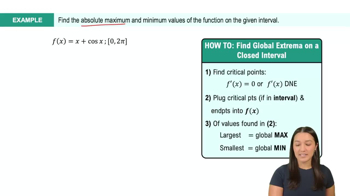Table of contents
- 0. Functions7h 52m
- Introduction to Functions16m
- Piecewise Functions10m
- Properties of Functions9m
- Common Functions1h 8m
- Transformations5m
- Combining Functions27m
- Exponent rules32m
- Exponential Functions28m
- Logarithmic Functions24m
- Properties of Logarithms34m
- Exponential & Logarithmic Equations35m
- Introduction to Trigonometric Functions38m
- Graphs of Trigonometric Functions44m
- Trigonometric Identities47m
- Inverse Trigonometric Functions48m
- 1. Limits and Continuity2h 2m
- 2. Intro to Derivatives1h 33m
- 3. Techniques of Differentiation3h 18m
- 4. Applications of Derivatives2h 38m
- 5. Graphical Applications of Derivatives6h 2m
- 6. Derivatives of Inverse, Exponential, & Logarithmic Functions2h 37m
- 7. Antiderivatives & Indefinite Integrals1h 26m
- 8. Definite Integrals3h 25m
5. Graphical Applications of Derivatives
Finding Global Extrema
Problem 4.1.51
Textbook Question
Absolute maxima and minima Determine the location and value of the absolute extreme values of ƒ on the given interval, if they exist.
ƒ(x) = sin 3x on [-π/4,π/3]
 Verified step by step guidance
Verified step by step guidance1
Identify the function f(x) = sin(3x) and the closed interval [-π/4, π/3].
Calculate the derivative f'(x) to find critical points where f'(x) = 0 or is undefined.
Solve the equation f'(x) = 0 to find the critical points within the interval [-π/4, π/3].
Evaluate the function f(x) at the critical points found and at the endpoints of the interval, x = -π/4 and x = π/3.
Compare the values obtained from the evaluations to determine the absolute maximum and minimum values on the interval.
Recommended similar problem, with video answer:
 Verified Solution
Verified SolutionThis video solution was recommended by our tutors as helpful for the problem above
Video duration:
3mPlay a video:
Was this helpful?
Related Videos
Related Practice










